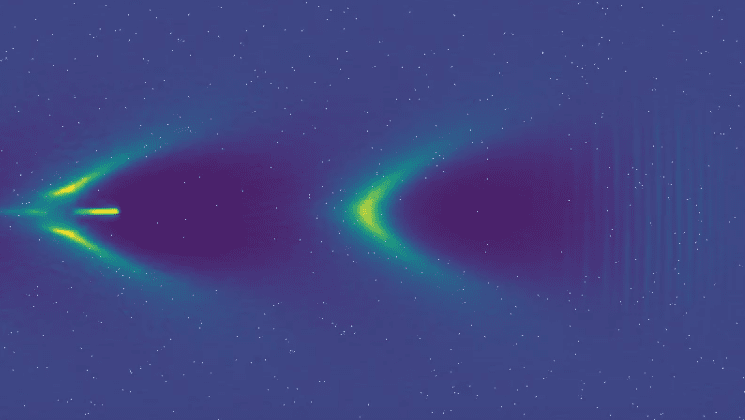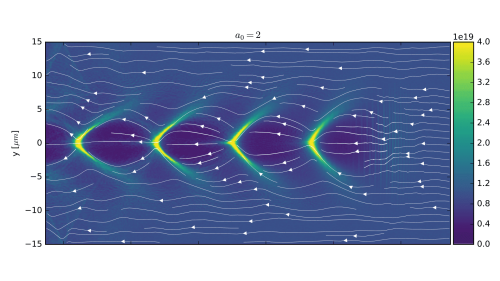
Lasers generate the most extreme fields achievable in the laboratory on mesoscopic and macroscopic spatial scales (only highly ionised heavy ions have higher fields, but on the Angstrom scale). Ultra-intense lasers achieve fields of 1013V/m and greater, alternatively these fields are on the order of 10 MV/µm or 10GV/mm. Particle accelerators using radiofrequency waves typically accelerate particles to MeV to GeV over distances of many metres to kilometres – making the use of laser fields very attractive.
Electron accleration is most efficient if an accelerating field can co-move with electrons over large distances. This is achieved by driving a wakefield (like the wave following a ship) using a powerful laser: The laser expels the electrons in its path (just like a ship pushes away the water) and the electrons feel a force that accelerates them. The figures show simulations of the plasma wave with and without an electron bunch being accelerated (the accelerating bunch is the dot in V-shape).
Publications:
- B. Lei, T. Teter, J. W. Wang, et al., "Flexible x-ray source with tunable polarization and orbital angular momentum from Hermite-Gaussian laser modes driven plasma channel wakefieldExternal link," Phys. Rev. Accel. Beams 22 071302, (2019)
- S. Kuschel, M. B. Schwab, M. Yeung, D. Hollatz, A. Seidel et al., "Controlling the Self-Injection Threshold in Laser Wakefield Accelerators"External link, Phys. Rev. Lett. 121 (15), 154801, (2018)
- B. Lei, J. Wang, V. Kharin, M. Zepf et al., "gamma-Ray Generation from Plasma Wakefield Resonant Wiggler"External link, Phys. Rev. Lett. 120 (13), 134801, (2018)
- J. W. Wang, C. B. Schroeder, R. Li, M. Zepf et al., "Plasma channel undulator excited by high-order laser modes"External link, Sci. Rep. 7, 16884, (2017)
- M. Yeung, S. Rykovanov, J. Bierbach, L. Li et al., "Experimental observation of attosecond control over relativistic electron bunches with two-colour fields"External link, Nat. Photonics 11 (1), (2017)
- S. Kuschel, D. Hollatz, T. Heinemann, O. Karger et al., "Demonstration of passive plasma lensing of a laser wakefield accelerated electron bunch"External link, Phys. Rev. Accel. 19 (7), 071301, (2016)

